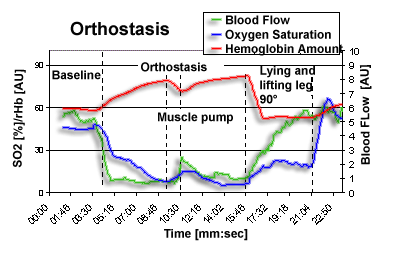Phlebology

Phlebology |

|
Venous ulcers and varices are widely spread due to the modern stress of standing and sitting as well as genetic disposition. Standing upright and the associated stress from gravity presents a challenge to the circulatory system. During change from lying to standing (orthostasis) the venous pressure in the legs increases from 10 mmHg to 100 mmHg; additionally, about 500 ml of blood sink into the veins in about 45 seconds. Blood flow decreases due to the arterio-venular reflex, oxygen saturation declines because of venous stasis and decreased blood flow [1]. If tissue damage is mainly caused by increased pressure, rheological changes or decreased oxygen saturation, is not yet clarified. With O2C new insights into the pathomechanism and assessment of arterio-venular reflex are possible, as are determination of temporal and quantitative increase of hemoglobin amount and oxygen saturation during orthostasis [2].
A further interesting field of application is the diagnosis of deep vein thrombosis. That, however, still needs clinical evaluation.

Figure 1: Orthostasis: Changing the position from lying to standing results in decreasing blood flow and oxygen saturation and increasing hemoglobin amount. Muscle contractions pump blood volume out of the leg, the hemoglobin amount decreases, and blood flow and oxygen saturation increase.